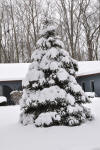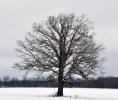|
 In
addition to protection from snow, ice and salt damage, some landscape plants
need further care during the winter. In
addition to protection from snow, ice and salt damage, some landscape plants
need further care during the winter.
Trees
such as maples,
crabapples and
sycamores often have long, vertical cracks in
their bark, usually, on the
southwest side of the tree. These "frost cracks"
occur on young trees on a cold but sunny winter day when the sun is at its
winter peak in the southwest sky. The smooth, dark bark absorbs the sun's
rays and expands but the shaded bark on the other side does not. The
resulting pressure cause the bark to split.
 To avoid this problem, keep the trunks of young, dark
barked trees covered with a light colored wrap until the bark matures.
Re-wrap the tree every few years to avoid girdling. To avoid this problem, keep the trunks of young, dark
barked trees covered with a light colored wrap until the bark matures.
Re-wrap the tree every few years to avoid girdling.
Wraps will also help prevent another common winter
problem: mouse damage. Mice will eat the tender young bark of trees during
the winter. Use a wrap or mesh wire barrier to keep mice away from the
trunk. Also, keep mulch, straw,
weeds or other materials where mice can hide
from accumulating around the trunk of trees.
Broadleaf evergreens include such plants as
rhododendrons,
azaleas and boxwoods. Since they maintain their large, fleshy leaves through
the winter, they face special problems in our climate.
 During winter, when the ground freezes, these plants are
unable to absorb water into their roots. On sunny but cold days, the leaves
warm enough to begin transpiring i.e. they begin to lose water. When the
frozen roots cannot replenish this supply, the leaves wilt. If the resulting
desiccation is too severe, the leaf will die. During winter, when the ground freezes, these plants are
unable to absorb water into their roots. On sunny but cold days, the leaves
warm enough to begin transpiring i.e. they begin to lose water. When the
frozen roots cannot replenish this supply, the leaves wilt. If the resulting
desiccation is too severe, the leaf will die.
To minimize this problem, keep broadleaf evergreens
watered until the ground freezes. Provide a site which is sheltered from
prevailing winds by using nearby plantings or constructing temporary
windbreaks.
 Chemical anti-transpirants may be effective in stopping
the water loss from broadleaf plants but they are often difficult to use.
The products tend to wash off and must be reapplied during the winter. The
weather does not always cooperate for proper application. Chemical anti-transpirants may be effective in stopping
the water loss from broadleaf plants but they are often difficult to use.
The products tend to wash off and must be reapplied during the winter. The
weather does not always cooperate for proper application.
|



